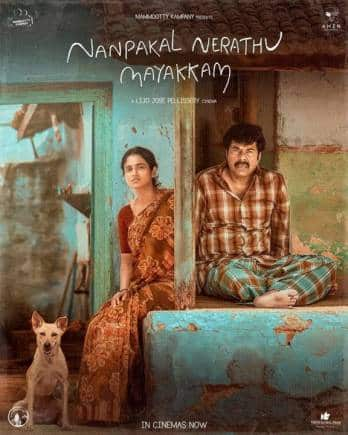



In Franz Kafka’s novella The Metamorphosis, a salesman inexplicably turns into an insect and discovers that the world instantly shuns him though he is the same person. Is it his form that makes him who he is or is it the essence of his personality, his thoughts and feelings? Lijo Jose Pellissery’s Nanpakal Nerathu Mayakkam, written by S. Hareesh, is also about a man who undergoes such a transformation – except that it is the inverse of what happens in The Metamorphosis. He retains his form but becomes another person.
Mammootty, the star, dissolves into the cranky personality of James. It’s like watching sugar being stirred into tea, the way the actor disappears into a role. This is a Malayali man who despises everything Tamil – from movie songs to the food and culture. He’s on a bus with his family and acquaintances who are returning from the famous Velankanni shrine in Tamil Nadu when all of them fall into a deep sleep. On waking, James suddenly thinks he is Sundaram, a Tamil man who had gone missing from a village that the bus is driving through.
Nanpakal has shades of Pellissery’s previous collaborations with S. Hareesh – Jallikattu (2019) and Churuli (2021). All three films use the village as a microcosm for the world; a place where magical events unfold to reveal human nature. In Jallikattu, a village goes searching for a buffalo and in the process, the boundaries between man and beast are blurred. In Churuli, ordinary human beings transform into abrasive, abusive people when they set foot into a village, caught in a hypnotic cycle. In Nanpakal, a busload of people go in search of a co-passenger – a man who looks the same, but his personality has changed completely.
The frequent wide shots (cinematography by Theni Eswar) create a sense of desolation within the viewer, as if we’re watching the characters from a great distance. This allows us to accept the absurdist universe for what it is, and also sharpens the helplessness of the characters who are caught in such a strange swirl of events.
The only person who embraces James in his new avatar is an old woman who cannot see but spends all day and night before the television. She has no trouble believing that James is her son, cackling madly at the dialogues she hears from the TV that is never switched off.
Pellissery uses popular culture brilliantly to set context for the scenes, and to accentuate humour. If you understand Malayalam and Tamil equally well, the experience is far richer.
The TV performs the role of a sutradhar, offering commentary on what’s happening ‘on the stage’ (a character in the film wisely quotes Shakespeare’s ‘All the world’s a stage’ to describe what is happening); dramatic lines and songs from Tamil cinema of the 1960s become relevant to contemporary incidents. It’s the only ‘background music’ for most of the film, but it’s necessary to foreground it to be amused by the subtle comedy.

Mammootty, fluent in both languages, is a joy to watch, but the film doesn’t make it into an ‘appreciate-the-star-at-his-peak’ exercise. So used are we to have the camera focussed on the actor’s face when he’s delivering a great performance that it almost feels frustrating that Pellissery refuses to do that in Nanpakal. When James breaks into mimicking Sivaji Ganesan from Gauravam, word for word, he’s at a local bar; his face is partially visible while irrelevant characters are placed closer to the camera, as if we’re watching this drunk man through a gap in the crowd. This is a cinematic moment but it receives a diffused treatment; when the film chooses to play up the drama – like James’ tour on a bike – it uses the door frames in the village to create the theatrics. The village is agog but James himself is unaware of the stir that he’s creating.
The film is about James and his disorienting experience, but there are others too who leave a mark, even if they aren’t prominent. Like the Sisyphean character of a woman who is plastering a wall with cowdung cakes – she watches James arrive and leave the village – and she’s still performing the same task, all day, every day.
Ramya Suvi plays James’ wife Sally while Ramya Pandian plays Poonkuzhali, Sundaram’s wife. Both the women are in a dilemma. Is this James or is this Sundaram? There’s an interesting shot composition that underlines their angst without a word of dialogue – Sally is sitting with her son who's consoling her while Poonkuzhali is standing with her daughter offering her similar strength. Right after this, we see James resting his head on his mother’s lap; the two wives may be wondering what will happen next, but the blind woman is oblivious to everyone else’s agony because she accepts James without any questions.
Nanpakal unfolds at a languid, mesmerising pace but is economical and efficient in what it wants to articulate. What does the last shot of the bus and the dog mean? How did any of this happen? Can a nap really lead to such a situation? Existentialists say that life has no intrinsic meaning but are able to appreciate the comedy in our frenzied efforts to find it. Watch Nanpakal from that perspective, and it becomes all the more rewarding.
Discover the latest Business News, Sensex, and Nifty updates. Obtain Personal Finance insights, tax queries, and expert opinions on Moneycontrol or download the Moneycontrol App to stay updated!
Find the best of Al News in one place, specially curated for you every weekend.
Stay on top of the latest tech trends and biggest startup news.